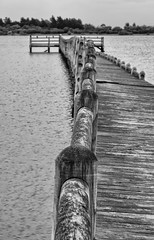
Search
Images for [empty query]; more images...
Extreme landscapes: A 21st century sublime
Research Papers, Lincoln University
Queenstown and Christchurch are twin poles of New Zealand's landscape of risk. As the country's 'adventure capital', Queenstown is a spectacular landscape in which risk is a commodity. Christchurch's landscape is also risky, ruptured by earthquakes, tentatively rebuilding. As a far-flung group of tiny islands in a vast ocean, New Zealand is the poster-child of the sublime. Queenstown and Christchurch tell two different, yet complementary, stories about the sublime. Christchurch and Queenstown are vehicles for exploring the 21st-century sublime, for reflecting on its expansive influence on shaping cultural landscapes. Christchurch and Queenstown stretch and challenge the sublime's influence on the designed landscape. Circling the paradoxes of risk and safety, suffering and pleasure, the sublime feeds an infinite appetite for fear as entertainment, and at the same time calls for an empathetic caring for a broken landscape and its residents.
Kaikoura: Tourist travel behaviour and recovery framework
Research Papers, Lincoln University
Initial recovery focus is on road access (especially the inland SH70) although attention also needs to be focussed on the timelines for reopening SH1 to the south. Information on progress and projected timelines is updated daily via NZTA (www.nzta.govt.nz/eq-travel ). Network analyses indicate potential day trip access and re-establishment of the Alpine Pacific triangle route. When verified against ‘capacity to host’ (Part 2 (15th December) there appears to potential for the reestablishment of overnight visits. Establishing secure road access is the key constraint to recovery. In terms of the economic recovery the Kaikoura District has traditionallyattracted a large number of visitors which can be grouped as: second home (and caravan) owners, domestic New Zealand and international travellers. These have been seen through a behaviour lens as “short stop”, ‘day” (where Kaikoura is the specific focal destination) and overnight visitors. At the present restricted access appears to make the latter group less amenable to visiting Kaikoura, not the least because the two large marine mammal operators have a strong focus on international visitors. For the present the domestic market provides a greater initial pathway to recovery. Our experiences in and reflections on Christchurch suggest Kaikoura will not go back to what it once was. A unique opportunity exists to reframe the Kaikoura experience around earthquake geology and its effects on human and natural elements. To capitalise on this opportunity there appears to be a need to move quickly on programming and presenting such experiences as part of a pathway to re-enabling domestic tourists while international visitor bookings and flows can be re-established. The framework developed for this study appears to be robust for rapid post disaster assessment. It needs to be regularly updated and linked with emerging governance and recovery processes.
Urban comfort in a future compact city: Analysis of open-space qualities i…
Research Papers, Lincoln University
The increase in urban population has required cities to rethink their strategies for minimising greenhouse gas impacts and adapting to climate change. While urban design and planning policy have been guided by principles such as walkability (to reduce the dependence on cars) and green infrastructure (to enhance the quality of open spaces to support conservation and human values), there have been conflicting views on what spatial strategies will best prepare cities for a challenging future. Researchers supporting compact cities based upon public Transit Oriented Development have claimed that walkability, higher density and mixed-uses make cities more sustainable (Owen, 2009) and that, while green spaces in cities are necessary, they are dull in comparison with shopfronts and street vendors (Speck, 2012, p 250). Other researchers claim that green infrastructure is fundamental to improving urban sustainability and attracting public space users with improved urban comfort, consequently encouraging walkability (Pitman and Ely, 2013). Landscape architects tend to assume that ‘the greener the better’; however, the efficiency of urban greenery in relation to urban comfort and urbanity depends on its density, distribution and the services provided. Green infrastructure can take many forms (from urban forests to street trees) and provide varied services (amended microclimate, aesthetics, ecology and so forth). In this paper, we evaluate the relevance of current policy in Christchurch regarding both best practice in green infrastructure and urban comfort (Tavares, 2015). We focus on the Christchurch Blueprint for rebuilding the central city, and critically examine the post-earthquake paths the city is following regarding its green and grey infrastructures and the resulting urban environment. We discuss the performance and appropriateness of the current Blueprint in post-earthquake Christchurch, particularly as it relates to the challenges that climate change is creating for cities worldwide.
Insuring earthquakes: How would the Californian and Japanese insurance pro…
Research papers, Victoria University of Wellington
Earthquakes are insured only with public sector involvement in high-income countries where the risk of earthquakes is perceived to be high. The proto-typical examples of this public sector involvement are the public earthquake insurance schemes in California, Japan, and New Zealand (NZ). Each of these insurance programs is structured differently, and the purpose of this paper is to examine these differences using a concrete case-study, the sequence of earthquakes that occurred in the Christchurch, New Zealand, in 2011. This event turned out to have been the most heavily insured earthquake event in history. We examine what would have been the outcome of the earthquakes had the system of insurance in NZ been different. In particular, we focus on the public earthquake insurance programs in California (the California Earthquake Authority - CEA), and in Japan (Japanese Earthquake Reinsurance - JER). Overall, the aggregate cost to the public insurer in NZ was $NZ 11.1 billion in its response to the earthquakes. If a similar-sized disaster event had occurred in Japan and California, homeowners would have received $NZ 2.5 billion and $NZ 1.4 billion from the JER and CEA, respectively. We further describe the spatial and distributive patterns of these different scenarios.



